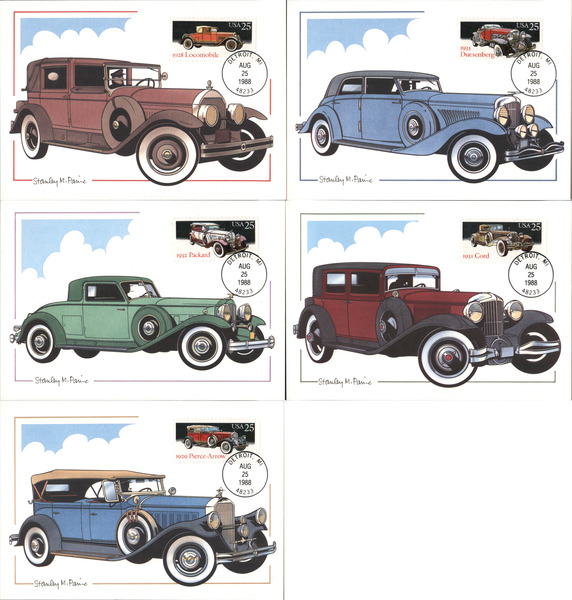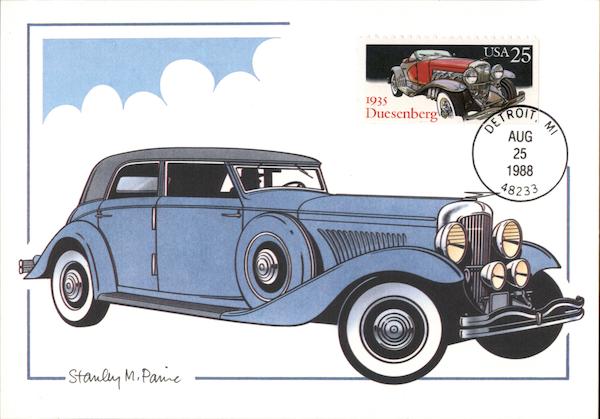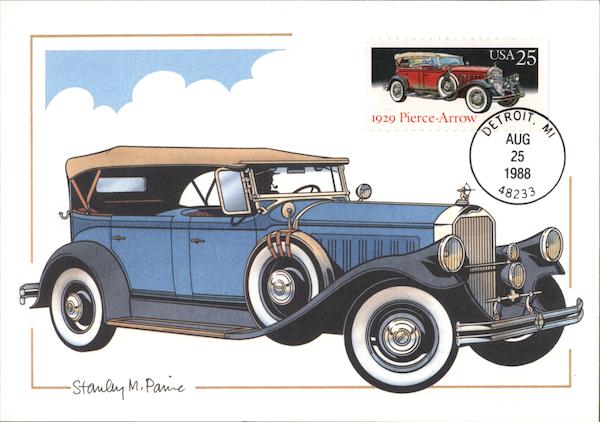Set of 5: Stanley M. Paine Cars 1988 25c
Front:
USA 25
1928 Locomobile TROIT,
MI
25
1988
48233
Stauly Mi Paine
US
25
1935
MI
DETROIT
Duesenberg
25
1988
48233
Stauley
M, Parine
USA 25
1932 Packard
DETROTT
25
1988
48233
Stauly M. Parine
MI
USA25
DETROTT
1931 Cord
25
1988
48233
Stauly MiParine
MI
USA 25
MI
DETROTT
1929 Pierce-Arrow
25
1988
48233
Stauley M. Paine
Back:
LOCOMOBILE
First Day of Issue: August 25, 1988
First Issue Location: Detroit, Michigan
A rather odd-looking contraption, the first effort of the Lo-
comobile Company was actually a welded bicycle frame-
work topped by a carriage body and equipped with a
twin-cylinder engine and a boiler beneath the driver's
seat. It sold for $600 — not much of a bargain, for it
required constant lubrication and water every twenty
miles. But from these humble beginnings grew a com-
pany of pride and a product of beauty and style. In fact,
as the years went by the Locomobile Company began to
produce some of the most luxurious and elegant touring
cars ever seen in America. With T-shaped cabs and long,
elegant body styles, running boards and sometimes con-
vertible roofs, the Locomobile evolved into a popular,
sporty vehicle, perfectly suited to the 1920's and
America's freewheeling way of life. By 1929, the Loco-
mobile Company was into its final year of production, and
its days of advertising “no stock parts or ready-made
units” had come to a close.
No. 88-48
©1988 The Maximum Card Collection
A Division of Unicover Corporation • Cheyenne, WY 82008-0007
Original painting by Stanley Paine
DUESENBERG
First Day of Issue: August 25, 1988
First Issue Location: Detroit, Michigan
This was the car coveted by the stars; the car that everyone
wished they could own. In the Golden Age of Hollywood,
flashy cars became the perfect accent and attention-
getter. And the Duesenberg was a favorite choice. To be
seen in one was an honor; to own one meant success.
Designed by Fred Duesenberg, these autos were ad-
vanced ... they were luxurious ... and they were deli-
ciously expensive. In short, they became the perfect status
symbol for producers like Howard Hughes and stars like
Mae West, and for the very rich like William Randolph
Hearst or New York Mayor Jimmy Walker. The Duesen-
berg cars were massive -- one model was thirteen feet
long -- with huge engines of race track quality. Body
styles came from an array of fine coaches designed by the
industry's best, and were ordered by the individual pur-
chaser from a book of styles especially suited to the
Duesenberg chassis. This magnificent car came to epito-
mize the good life in America, with all of its accompany-
ing glitter, glamour and gleam.
No. 88-52
©1988 The Maximum Card Collection
A Division of Unicover Corporation Cheyenne, WY 82008-0007
Original painting by Stanley Paine
PACKARD
First Day of Issue: August 25, 1988
First Issue Location: Detroit, Michigan
The Packard was born at the turn of the century — as the
automobile industry itself began to take hold. The history
of this elegant auto began with a consumer complaint.
James W. Packard had bought a car from Alexander
Winton, the largest manufacturer of automobiles in the
United States at that time. But Packard's grievances were
many, and finally Winton responded that if Packard didn't
like the car he had, maybe he should build one of his own.
So Packard, his brother, and a few talented employees
formed the Packard Motor Company – a name that
– a
would adorn elegant cars for more than forty years.
Through these years, Packard was the company to watch
for innovation. Packard was the first to replace the tiller
with a steering wheel, and to pioneer the H-slot shifter in
American cars. In 1924, Packard offered the first reasona-
bly priced straight-eight engine. In 1928, at its height,
Packard sold 50,000 luxury cars to the American well-to-
do, “a sign of life's best riches and social rewards."
--
No. 88-51
©1988 The Maximum Card Collection
A Division of Unicover Corporation . Cheyenne, WY 82008-0007
Original painting by Stanley Paine
CORD
First Day of Issue: August 25, 1988
First Issue Location: Detroit, Michigan
In 1926, Erret Lobban Cord founded an automobile
empire. After agreeing to help bring the Auburn Automo-
bile Company out of debt in 1924, Cord spent the next two
years organizing what would become Auburn-Cord-
Duesenberg – dubbed a maker of cars “classic among
classics." Cord gathered the most talented, ambitious,
and imaginative engineers in the country to design his
cars. In 1931, his company sold 28,130 vehicles —
topping DeSoto, Hudson, and Packard in sales for that
year. The 810 model, otherwise known as the “Coffin-
nosed Cord," was introduced in 1935. Featuring front-
wheel drive and a preselector gearbox, it had a body of
advanced design with retractable headlamps and a beau-
tiful, wrap-around grille, and it was expensively furnished
and most carefully assembled. In 1937, another model —
the 812 — offered the obviously upper-class feature of a
special chauffeur division. The classic Cords were diffi-
cult to build, and thus only 3,000 of the 810 and 812
models were ever produced.
No. 88-50
©1988 The Maximum Card Collection
A Division of Unicover Corporation . Cheyenne, WY 82008-0007
Original painting by Stanley Paine
PIERCE-ARROW
First Day of Issue: August 25, 1988
First Issue Location: Detroit, Michigan
The magnificent Pierce-Arrow automobile was one of
America's most prestigious cars. Demand for its sleek
styling and renowned performance generally exceeded
production – for this was a limited-edition vehicle.
Options included such exotics as bulged rooftops spe-
cially designed to accommodate the hats of elegant ladies
– hats bedecked with ostrich plumes and furbelows.
And, many of the cars were sold with two interchangeable
bodies, one for summer and one for winter. As early as
1904, the Great Arrow — one of the first of the Arrow line
— won the Glidden Tour, a reliability test which estab-
lished the reputation of the Arrow vehicles. By 1915, the
Pierce-Arrow was considered the most prestigious auto-
mobile in its price class. Through the 1920's and early
1930's, Pierce-Arrow continued production despite
growing financial problems. In 1933, Pierce-Arrow made
a showing at the Chicago World's Fair with its spectacular
Silver Arrow — billed as a car of the future. It was one of
an edition limited only to five.
No. 88-49
©1988 The Maximum Card Collection
A Division of Unicover Corporation Cheyenne, WY 82008-0007
Original painting by Stanley Paine












